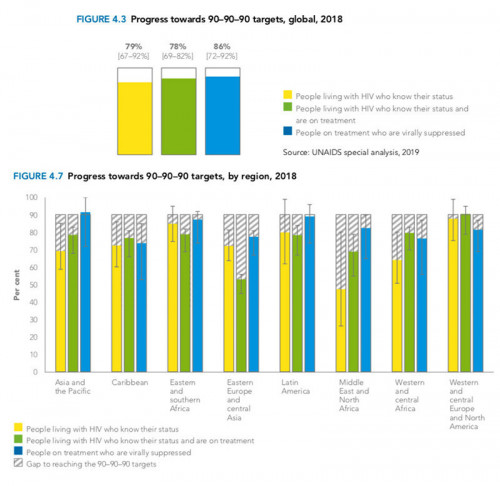The Joint United Nations Program on HIV/AIDS (UNAIDS) has released its latest report on the status of the HIV epidemic and the global response in advance of the International AIDS Society Conference on HIV Science in Mexico City.
The report highlights the impact community programs have had in expanding access to HIV treatment, supporting adherence and preventing new infections. However, it also shows that this progress is slowing down and has been uneven, and that global funding for the HIV/AIDS response has fallen for the first time ever, by nearly US$1 billion. In 2018, US$19 billion was available for the response, falling US$7.2 billion short of the estimated US$ 26.2 billion needed by 2020.

Courtesy of UNAIDS
Some countries are meeting or exceeding the UNAIDS 90-90-90 targets of 90% of people living with HIV knowing their status, 90% of those diagnosed being on antiretroviral therapy and 90% of those on treatment having viral suppression by 2020, but others are falling behind.
Worldwide, in 2018, 79% of people with HIV knew their status, 78% of those were on treatment and 86% of those had viral suppression. But these figures hide some wide disparities across regions, with Eastern Europe and Central Asia, the Middle East and North Africa, and Western and Central Africa falling behind on all three measures.

Courtesy of UNAIDS
Globally, new infections and AIDS-related deaths continue to decline, but less steeply. The number of HIV-positive people on treatment continues to rise and appears on track to meet the 2020 target. According to UNAIDS global estimates, in 2018 there were 37.9 million people worldwide living with HIV, 23.3 million (62%) with access to antiretroviral therapy, 1.7 million acquired HIV and 770,000 deaths from AIDS-related illnesses.
Members of key populations and their sex partners now account for more than half of the 1.7 million people with newly acquired HIV last year, according to the report. These include men who have sex with men, transgender people, sex workers, people who inject drugs and prisoners. In Eastern Europe and Central Asia and in the Middle East and North Africa, these populations account for an estimated 95% of new infections. Here too, who bears the greatest burden of the epidemic varies widely by region.
Despite the availability of antiretrovirals that can prevent mother-to-child HIV transmission, just 82% of pregnant women have access to them, resulting in 160,000 new infections among children, falling well short of the target of less than 40,000.
Regarding HIV prevention, the report says that only around 300,000 people worldwide—including 130,000 in the US—are using pre-exposure prophylaxis (PrEP). Similarly, although people who inject drugs account for a high proportion of new infections in some regions, many lack access to harm reduction services.
Although it is harder to gauge progress in this area, the report notes that stigma, discrimination, criminalization, harassment and violence remain problems for many people living with HIV.
“We urgently need increased political leadership to end AIDS,” UNAIDS interim executive director Gunilla Carlsson said in a press release. “This starts with investing adequately and smartly and by looking at what’s making some countries so successful. Ending AIDS is possible if we focus on people, not diseases, create road maps for the people and locations being left behind, and take a human rights-based approach to reach people most affected by HIV.”
Click here to read the full report.







Comments
Comments